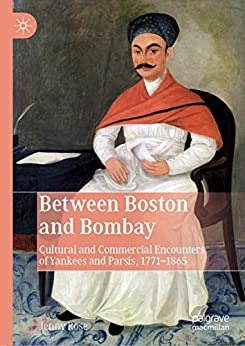Dr. Jenny Rose, in her vibrant and exciting new book Between Boston and Bombay: Cultural and Commercial Encounters of Yankees and Parsis, 1771-1865, shares with our readers what propelled her to research and write this refreshing book.
 The discovery of a Parsi broker on the walls of a New England museum piqued our good friend Dr. Jenny Rose’s curiosity. What would contemporary residents along the northeastern coast of America have known of Bombay, particularly its Parsi Zoroastrian community? And what did Parsis think of the Americans who began to visit their offices and warehouses not long after the formal ending of the Revolutionary War?
The discovery of a Parsi broker on the walls of a New England museum piqued our good friend Dr. Jenny Rose’s curiosity. What would contemporary residents along the northeastern coast of America have known of Bombay, particularly its Parsi Zoroastrian community? And what did Parsis think of the Americans who began to visit their offices and warehouses not long after the formal ending of the Revolutionary War?
Jenny Rose addresses some of these questions, while exploring many aspects of commercial interaction (such as the lucrative ice trade from Boston, and the American involvement in the opium trade with China), as well as exchanges of ideas between Parsis and Yankees relating to social customs, Indian art and architecture, and, occasionally, the religious beliefs and practices of the descendants of the ancient Persians. The early records of American merchant mariners tend to offer a broad perspective on the Zoroastrian religion, testifying not only to the development of long-lasting commercial alliances, but also to the bonds of friendship that formed across the seas.
Jenny continues … While combing through the collections of various libraries and archives in New England for materials relating to my most recent book, I came across many documents that had not be viewed for decades, and a few that contained passages which had gone unnoticed for centuries. One such manuscript was a letter written by a 22 year-old merchant mariner who had arrived in Bombay in the fall of 1788.
That September, the letter’s author, Elias Hasket Derby Junior (known as “Hasket”), wrote to his father back home in Salem, Massachusetts:
I arrived here on the 8th of this month, my passage from the Isle of France [Mauritius] being only 24 Days. I find that we are here on the same footing with all other strangers being subject to a duty on most goods… The cotton is better than what I supposed… My Broker’s name is Nasservanjie Monackjie, he is said to be worth 200,000£ Sterling.
The letter itself is remarkable for several reasons, not least that Hasket is thought to have been the first American to bring American-owned ships into Bombay harbor. The cotton that he bought from his Bombay broker and shipped back to Salem on the Peggy was the first such cargo to be sent from Bombay to the United States. Perhaps the most astonishing information revealed in the above extract is that Hasket’s broker, a Parsi named Nusserwanji Maneckji, had an estimated wealth at today’s exchange rate of over seven million US$!
Before finding Hasket’s letter, I had already come across Nusserwanji Maneckji – not in Mumbai, but on a visit to Salem. On display in the East India Marine Hall of the city’s Peabody Essex Museum, was a small oil painting of a Bombay merchant, identified as “Nasservangee Manackjee Wadia.” This portrait was among the earliest donations to the museum’s collection, made by Salem sea captain at the beginning of the 19th century.
P.S. Did you know that the poem describing the “rocket’s red glare” over Fort McHenry in 1814 was composed on the deck of a Wadia-built ship from Bombay?
Jenny Rose teaches Zoroastrian Studies at Claremont Graduate University, California, USA. She has written two books on the religion—Zoroastrianism: An Introduction and Zoroastrianism: A Guide for the Perplexed—and lectures extensively across North America, Europe, and India

